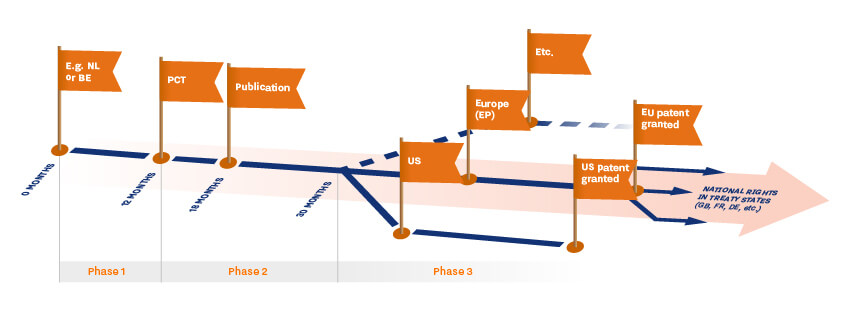Can Patents Be Renewed? Exploring Maintenance and Duration
The question "Can patents be renewed?" brings a number of considerations to the forefront. This piece will delve into the details of patent renewal and the ongoing upkeep needed for different kinds of patents.
This discussion will cover how utility patents can last up to two decades if properly maintained, contrasting this with design and plant patents, which expire after fourteen years without continuous financial support. We’ll also highlight the need for prompt fee payments to retain legal enforceability and examine the repercussions of failing to make these payments on time. In the end, you'll be well-versed in the nuances of patent renewal, understanding how and when it applies.
We will also delve into solutions for when a patent lapses due to unpaid fees and explore how to broaden patent coverage internationally. Finally, you'll find insights into acquiring expired patents, alongside the crucial advice of seeking professional guidance when navigating such intricate legal avenues.
Table of Contents
Can Patents be Renewed?
Utility Patents: Longevity and Maintenance (Up to 20 Years)
Design and Plant Patents: Expiration Without Ongoing Financial Commitment (14 Years)
Utility Patent Maintenance Fees: Payment Procedures
The Significance of Timely Payments in Maintaining Enforceability
Consequences of Non-Payment of Required Maintenance Fees
Reviving Lapsed Patents: Options Due to Non-Payment
The Six-Month Grace Period Window for Missed Payments
Penalty Surcharges During the Reinstatement Process
Broadening Patent Coverage Internationally
Advantages of Implementing Multinational Strategies
Reciprocal Agreements Between Participating Nations
Acquiring Expired Patents
Using Online Databases, such as Google Patents or USPTO’s Public PAIR system
Negotiating with Previous Patent Owners for Acquisition
Seeking Professional Expertise
The Necessity of Professional Guidance During Renewal
Avoiding Potential Risks and Costly Errors
Conclusion
Can Patents be Renewed?
While the straightforward answer to "Can patents be renewed" is no, the reality is that some patents need continued upkeep to ensure their continued enforceability, a process tied to their type and the period of validity.
Understanding a patent's term is vital for businesses seeking to shield their innovations. Various patent types exist, including utility, design, and plant patents, each subject to distinct durations and maintenance protocols.
Utility Patents: Lasting up to 20 Years with Proper Maintenance
A utility patent is valid for up to two decades from the filing date, providing proper upkeep is maintained. The USPTO necessitates specific maintenance fee payments at set intervals after patent issuance, vital for upholding the validity of the patent and maintaining protection under intellectual property laws. This process is essential for keeping your invention protected by law.
Design and Plant Patents: Expiring After 14 Years Without Ongoing Financial Upkeep
Design patents, focused on the ornamental aspects of an item, expire after 14 years without any ongoing financial responsibilities for the patent holder. Similarly, plant patents, issued for novel plant varieties resulting from asexual methods, also adhere to a 14-year term without any additional payments required.
Regarding the question, "Can patents be renewed?" it's crucial to understand the lifespan and maintenance requirements of utility, design, and plant patents. Doing so ensures continued legal enforceability. Timely payments of maintenance fees for a utility patent are critical to its continued validity and enforceability.
Safeguard your invention with a patent. Utility patents are good for up to 20 years, whilst design and plant patents expire after 14. #PatentProtection #Innovation Click to Tweet
Paying Maintenance Fees for Utility Patents
Though a simple "no" may answer “Can patents be renewed", scheduled maintenance fees are still mandated throughout the duration of your patent's lifespan.
To retain protection via a utility patent, it's imperative to settle three maintenance fees at specified milestones post-issuance. Payments are due at 3.5, 7.5, and 11.5 years after the USPTO grants the utility patent. These payments must be made to maintain enforceability over time. The price of each fee increases with the patent's age. These fees may also fluctuate depending on various factors, like the invention's size or intricacy.
Importance of Prompt Payments in Maintaining Enforceability
Maintaining enforceability is essential in protecting your intellectual property against potential infringers who might try to use your invention without authorization. By paying these fees promptly, you make sure your patent rights stay active throughout their whole term.

Consequences of Failing to Pay Required Maintenance Fees
Lapsed patents: If payments are not made by the deadline, including the six-month grace period, the utility patent will lapse and lose its legal standing.
Invention enters the public domain: When a patent expires, anyone is free to utilize or sell products based on the invention, without concern for legal consequences.
Loss of revenue: Failing to maintain your utility patent can lead to lost licensing prospects or the inability to take legal action against infringers, which can negatively impact your revenue stream.
Maintenance fee payments for utility patents are a vital step in ensuring patent enforceability. Potential consequences of non-payment and the patent reinstatement process should be taken into consideration.
Don’t let your patent lapse. Pay maintenance fees at 3.5, 7.5 & 11.5 years after issuance to maintain enforceability and protect your IP rights #patentprotection #IPrights Click to Tweet
Reinstating Lapsed Patents Due to Non-Payment
If a patent holder misses a payment deadline, the option to reinstate the patent still exists. The United States Patent and Trademark Office (USPTO) provides a six-month grace period post the fee's due date. During this period, late payments can be made, accompanied by penalties, allowing reinstatement upon a successful submission.
Six-Month Grace Period for Missed Payments
The USPTO recognizes that circumstances sometimes cause delays in paying maintenance fees. They allow an extra six months from the initial deadline to let patent holders submit overdue payments without losing rights to the invention. However, it is essential to observe this extension window. Missing it can result in the permanent loss of patent protection.
Penalty Surcharges During Reinstatement
Alongside the overdue maintenance fee, a penalty is levied during the grace period. These added fees from the USPTO are meant to dissuade delays and vary based on factors such as the company size and the invention’s intricacy (see the current fee schedule here). Both the fee and surcharge must be paid to maintain exclusive rights.
It's critical to recognize that patent renewal is not automatic. Patent holders must file for renewal through the USPTO. Seasoned patent attorneys can assist with this procedure, ensuring the patent owner keeps their rights.
Reinstating a lapsed patent, stemming from non-payment, is achievable during the six-month grace period. However, penalty surcharges may apply. Upon expiration, the invention falls into the public domain, allowing free use and sale. Expanding international patent coverage is beneficial and involves reciprocal agreements between participating nations.
Don’t lose your patent protection. Renewal is crucial. Experienced attorneys can help with the process and ensure you maintain your exclusive rights. #patentrenewal #intellectualproperty Click to Tweet
Broadening Patent Coverage Internationally
In the current global marketplace, maintaining a competitive advantage necessitates that firms secure their intellectual property both domestically and internationally. Obtaining patent protection in multiple countries safeguards your invention against potential infringement by competitors operating outside of your home country. Therefore, even if the answer to the question, "Can patents be renewed", is negative, there are other ways to extend the scope of your IP protection.
Advantages of Implementing Multinational Strategies
Enhanced protection: By acquiring patents in several jurisdictions, you can effectively stop unauthorized use or sale of your invention across various markets.
Increased market opportunities: With granted patents in multiple countries, you're able to more broadly license or sell your technology, leading to potentially higher revenue streams.
Leveraging international treaties: Various countries are participants in international agreements such as the Patent Cooperation Treaty (PCT), which streamlines the patent application procedure in member states.
Reciprocal Agreements Between Participating Nations
The PCT offers inventors the capability to submit a single international application, which holds effect across all treaty signatories. By adhering to specific protocols outlined under this treaty, applicants may secure national patents in each designated state, sidestepping separate filing processes. Additionally, further bilateral and regional treaties like the European Patent Convention (EPC) streamline cooperation across borders on intellectual property matters between specific sets of nations.








Comments (0)
No comments yet. Be the first to comment!